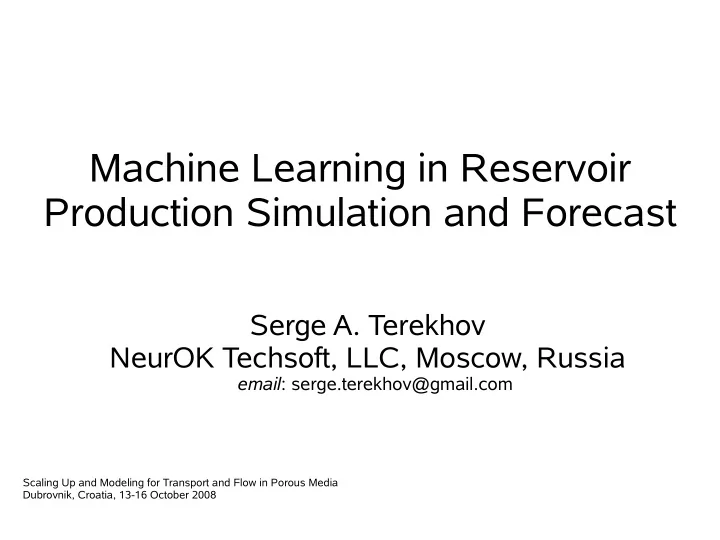

Machine Learning in Reservoir Production Simulation and Forecast Serge A. Terekhov NeurOK Techsoft, LLC, Moscow, Russia email : serge.terekhov@gmail.com Scaling Up and Modeling for Transport and Flow in Porous Media Dubrovnik, Croatia, 13-16 October 2008
Topics and Goals ● Goals – Look at one of topmost levels of model upscaling – dependencies between solution functionals – Consider Machine Learning (ML) as possible relevant technology for these levels ● Topics covered – Basic problem formulations in ML context – Illustrative applications and benefits
To the top of upscaling hierarchy ● Can we upscale original problem of reservoir simulation to the level of functional dependence between observed outputs (e.g. production rates) and controlled inputs (e.g. wells regimes)? ● Is this the only way to do this from original equations? – Possibly, alternatives exist: functional and probabilistic dependencies can be simulated by Machine Learning algorithms (neural networks and others)
OBSERVATIONS (not so easy) PHYSICS EQUATIONS MACHINE LEARNING ● ML algorithms are naturally ● PE are the best for direct utilize observations, and problems suitable both for direct and ● PE give useful hints to ML inverse problems – Critical scale factors ● ML feedbacks to PE – Conservation laws – Factors influence – Constrains – Optimal factor values – Feasibility tests
Models for what? ● Modelling for synthetic description of many simulator runs and experimental observations – “What-if” tools – inverse problems ● Modelling for prediction – Prolongation of system trajectory in time – Future responses to changing controls ● Machine Learning can serve for both
Formulations of ML tasks ● Requested application problem is described in terms of input variables (controlled and uncontrolled) and outputs. Later directly represent variables to be estimated. ● Datasets are collected from simulations and/or observations in the form of pairs of input-output vectors. ● Machine Learning algorithm provides the IO dependence. – Functional view – provide approximation of unknown function – Probabilistic view – estimate most probable response to a given input (whole probability distribution is preferable)
Types of ML tasks ● Classification problem – Output variable(s) represents two ore more descriptive alternatives ( classes ). Current input vector belongs to one of them. ● Regression problem and conditional probability estimation – Output(s) is typically real-valued. ● Other (less frequent) problems – Clustering (unsupervised, no predefined classes and class labels – Reinforcement learning (rewards or punishments are given instead of known output values.
Classification example ● Problem: Hydraulic fracturing is one of successful methods of production intensification. Fracturing efficiency for the particular well is quite uncertain and strongly depends on many factors (used as inputs): – Proppant parameters, pumping rate, perforation, watercut, surround media structure, well “history”, etc. ● Approach: consider classification of wells into two classes (“high” and “low” expected efficiency). ● Solution: neural classifier trained on known examples of previous fractures can predict the outcome. – Candidate wells are ordered so that most perspective wells for future fracturing planning are identified
Results: 30 wells of 100 Multiple efficiency is over 90% Sorted by actual output, 30 best forecasted are in green
Regression example ● Forecast of future scenario of well production (product and watering) from the production history and areal pumping. ● Regression model uses embedded delayed time series as inputs and estimates both expectation and variance of future production. ● Model can be used in control applications and field planning
Quality of 1-year forecast 1 2 1 0 8 6 4 2 0 0 5 0 1 0 0 1 5 0 2 0 0 2 5 0 3 0 0 Matched history NARX prediction
Machine Learning tools ● Neural Networks Example: Cascade Neural Network Gaussian likelihood optimization with CG ● Probabilistic and Outputs R clustering trees ● SVM Growing cascade ● Kohonen maps Hidden neurons ● GA and other Inputs, [1;b] optimization
Conclusions and benefits ● Machine Learning methods can fruitfully enforce mathematical modelling at topmost level of upscaling. ● Trained models can serve as surrogates for optimization tasks and inverse formulations ● Both simulated and observed data can be aggregated in one predictive model ● Broad area of applications in energy industry ● Thank You!
NeurOK Techsoft, LLC
Recommend
More recommend